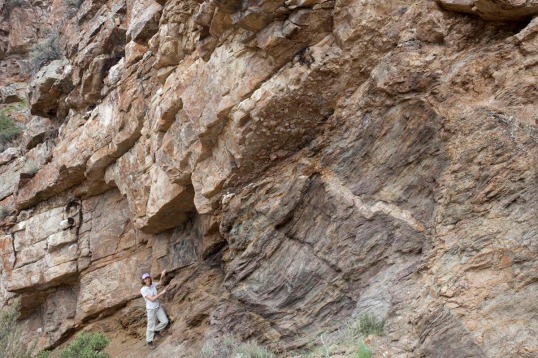As it turns out, the “Great Unconformity”, the contact between Cambrian sedimentary rock and the underlying Precambrian basement rock, is a regional feature –it’s not only in the Grand Canyon, but found all over the Rocky Mountain West –and for that matter, it’s even in the midwest. As an example, here are a couple photos from the Teton Range in Wyoming.

The yellow arrow points to the contact between the Cambrian Sandstone and underlying Precambrian metamorphic rock... the Great unconformity.
This top photo shows the Grand Teton (right) and Mt. Owen (left) in the background… in the foreground, you can see a flat bench, which is underlain by flat-lying Cambrian sandstone. Below that are darker-colored cliffs of Precambrian metamorphic rock. The unconformity is right at their contact (arrow).
Also notice that the Grand Teton and Mt. Owen are made of metamorphic (and igneous) rock –but they’re much much higher in elevation than the sandstone. That’s because there’s a fault, called the “Buck Mountain fault” that lies in-between the two. The Buck Mountain fault moved the rock of the high peaks over the ones in the foreground during a mountain-building event at the end of the Mesozoic Era. Because the metamorphic and igneous rock is so much more resistant to erosion than the sandstone, it stands up a lot higher.

Precambrian metamorphic and igneous rock of the Teton Range and overlying sedimentary rock.
This lower photo shows the view of the Teton range from the top of the sandstone bench (appropriately called “Table Mountain”). As you look eastward towards the range, you can pick out the Buck Mountain fault (between the metamorphic and igneous rock of the high peaks) and the Cambrian sedimentary rock (the layered rocks). Significantly, the Cambrian rocks, just like in the Grand Canyon, consist of sandstone, overlain by shale, overlain by limestone.
And geologic time… remember… for the sandstone to be deposited on the metamorphic or igneous rock, the metamorphic and igneous rock had to get uplifted from miles beneath the surface and exposed at sea level. And since then, it’s been uplifted to the elevation of The Grand Teton (13370′) and Mt. Owen (12, 928′) !
Click here to see more photos of unconformities.
or… click here to see a geologic map of Grand Teton National Park, Wyoming.
Posted in
Geologic Time,
Geology,
mountains,
photography and tagged
Cambrian,
creationism,
geologic time,
geologic time photos,
geology,
geology pictures,
geophotography,
gneiss,
Grand Teton National Park,
igneous rocks,
mountains,
national parks,
nature,
photography,
science,
Tetons,
unconformity,
young earth creationism |


 From the geologic map, modified from Bishop and Smith, 1990, you can see how the brown-colored canyon-filling basalt, (called the “Intracanyon Basalt”) forms narrow outcrops within today’s Crooked and Deschutes canyon areas. It erupted about 1.2 million years ago and flowed from a vent about 60 miles to the south. You can also see that most of the bedrock (in shades of green) consists of the Deschutes Formation, and that there are a lot of landslides along the canyon sides.
From the geologic map, modified from Bishop and Smith, 1990, you can see how the brown-colored canyon-filling basalt, (called the “Intracanyon Basalt”) forms narrow outcrops within today’s Crooked and Deschutes canyon areas. It erupted about 1.2 million years ago and flowed from a vent about 60 miles to the south. You can also see that most of the bedrock (in shades of green) consists of the Deschutes Formation, and that there are a lot of landslides along the canyon sides.



